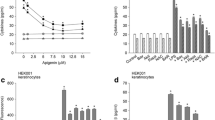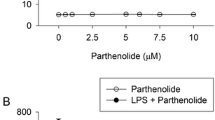Abstract
Capsaicin, a major pungent constituent of red pepper (Capsicum annuum L.) possesses a vast variety of pharmacologic and physiologic activities. Despite its irritant properties, the compound exerts anti-inflammatory and anti-nociceptive effects. Previous studies from this laboratory revealed that capsaicin, when topically applied onto dorsal skin of female ICR mice, strongly attenuated activation of NF-κB and AP-1 induced by the typical tumor promoter, 12-O-tetradecanoylphorbol-13-acetate (TPA), which may account for its anti-tumor promoting activity in mouse skin. In the present work, we have found that capsaicin suppresses TPA-stimulated activation of NF-κB through inhibition of IκBα degradation and blockade of subsequent nuclear translocation of p65 in human promyelocytic leukemia HL-60 cells. Methylation of the phenolic hydroxyl group of capsaicin abolished its inhibitory effect on NF-κB DNA binding. Likewise, TPA-induced activation of AP-1 was mitigated by capsaicin treatment.
Similar content being viewed by others
References
Abate, C., Patel, F. J., Rauscher, T. III and Curran, T., Redox regulation of fos and jun DNA-binding activtyin vitro.Science, 249, 1157–1161 (1990).
Angel, P., and Karin, M., The role of Jun, Fos and the AP-1 complex in cell proliferation and transformation.Biochim. Biophys. Acta, 1072, 129–157 (1991).
Baeuerle, PA, IkappaB-NF-kappaB structures: at the interface of inflammation control.Cell, 95, 729–731 (1998).
Baeuerle, P.A. and Baltimore, D., NF-kappaB: ten years after.Cell, 87, 13–20 (1996).
Barnes, P. and Karin, M., Nuclear factor-κB-a pivotal transcription factor in chronic inflammatory diseases.N. Eng. J. Med., 336, 1066–1071 (1997).
Brar, S.S., Kennedy, T.P., Whorton, A.R., Sturrock, A.B., Huecksteadt, T.P., Ghio, A.J. and Hoidal, J.R., Reactive oxygen species from NAD(P)H:quinone oxidoreductase constitutively activate NF-κB in malignant melanoma cells.Am. J. Physiol. Cell Physiol., 280, C659-C676 (2001).
Chabot-Fletcher, M., Transcription factor NF-κB: an emerging anti-inflammatory drug target.Pharmacol. Rev. Commun., 8, 317–324 (1996).
De, A.K. and Ghosh, J.J., Studies on capsaicin inhibition of chemically-induced lipid peroxidation in the lung and liver tissues of rat.Phytother. Res., 6, 34–37 (1992).
Han, S.S., Keum, Y.-S., Seo, H.-J. and Surh, Y.-J., Curcumin suppresses activation of NF-κB and AP-1 induced by phorbol ester in cultured human promyelocytic leukemia (HL-60) cells.J. Biochem. Mol. Biol., 35, 337–342 (2002).
Han, S.S., Keum, Y.-S., Seo, H.-J., Chun, K.-S., Lee, S.S. and Surh, Y.-J., Capsaicin suppresses phorbol ester-induced activation of NF-κB/Rel and AP-1 transcription factors in mouse epidermis.Cancer Lett., 164, 119–126 (2001).
Harvey, J.S., Davis, C., James, I.F. and Burgess, G.M., Activation of protein kinase C by the capsaicin analogue resiniferatoxin in sensory neurons.J. Neurochem., 65, 1309–1317 (1995).
Janusz, J.M., Buckwalter, P.A., Young, P.A., LaHann, T.R., Farmer, R.W., Kasting, G.B., Loomans, M.E., Kerckacrt, G.A., Maddin, C.S., Berman, E.F., Bohne, R.L., Cupps, T.L. and Milstein, J.R., Vanilloids. 1. Analogs of capsaicin with antinociceptive and anti-inflammatory activity.J. Med. Chem., 36, 2595–2604 (1993).
Joe, B. and Lokesh, B.R., Role of capsaicin, curcumin, and dietary n-3 fatty acids lowering the generation of reactive oxygen species in rat peritoneal macrophages.Biochim. Biophys. Acta, 1224, 255–263 (1994).
Jung, M.Y., Kang, H.J. and Moon, A., Capsaicin-induced apoptosis in SK-Hep-1 hepatocarcinoma cells involves Bcl-2 down-regulation and caspase-3 activation.Cancer Lett., 165, 139–145 (2001).
Kim, J.-D., Kim, J.-M., Pyo, J.-O., Kim, S.-Y., Kim, B.-S., Yu, R. and Han, l.-S., Capsaicin can alter the expression of tumor forming-related genes which might be followed by induction of apoptosis of a Korean stomach cancer cell line, SNU-1.Cancer Lett., 120, 235–241 (1997).
Kong, A.-N. T., Yu, R., Chen, C., Mandlekar, S. and Primiano, T., Signal transduction events elicited by natural products.Arch. Pharm. Res., 23, 1–16 (2000).
Lee, Y.S., Nam, D.H. and Kim, J.A., Induction of apoptosis by capsaicin in A172 human glioma cells.Cancer Lett., 161, 121–130 (2000).
Morré, D.J., Chueh, P.J. and Morré, D.M., Capsaicin inhibits preferentially the NADH oxidase and growth of transformed cells in culture.Proc. Natl. Acad. Sci. USA, 92, 1831–1835 (1995).
Morré, D.J., Sun, E., Geilen, C., Wu, L.Y., de Cabo, R., Krasagakis, K., Orfanos, C.E. and Morre, D.M., Capsaicin inhibits plasma membrane NADH oxidase and growth of human and mouse melanoma lines.Eur. J. Cancer, 32A, 1995–2003 (1996).
Macho, A., Blàzquez, M.-V., Navas, P. and Muñoz, E., Induction of apoptosis by vanilloid compounds does not requirede novo gene transcription and activator protein 1 activity.Cell Growth Differ, 9, 277–286 (1998).
Macho, A., Calzado, M.A., Munoz-Blanco, J., Gomez-Diaz, C., Gajate, C., Mollinedo, F., Navas, P. and Muñoz, E., Selective induction of apoptosis by capsaicin in transformed cells: the role of reactive oxygen species and calcium.Cell Death Differ, 6, 155–165 (1999).
Morré, D.J., Chueh, P.J. and Morré, D.M., Capsaicin inhibits preferentially the NADPH oxidase and growth of transformed cells in culture.Proc. Natl. Acad. Sci. USA, 92, 1831–1835 (1995).
Morré, D.J., Sun, E., Geilen, C., Wu, L.Y., de Cabo, R., Krasagakis, K., Orfanos, C.E. and Morré, D.M., Capsaicin inhibits plasma membrane NADH oxidase and growth of human and mouse melanoma cell line.Eur. J. Cancer, 32A, 1995–2003 (1996).
Park, K.-K., Chun, K.-S., Yook, J. I., and Surh, Y- J., Lack of tumor promoting activity of capsaicin, a principal pungent ingredient of red pepper, in mouse skin carcinogenesis.Anticancer Res., 18, 4201–4206 (1998).
Reddy, A.Ch. and Lokesh, B.R., Studies on anti-inflammatory activity of apice principles and dietary n-3 polyunsaturated fatty acids on carageenan-induced inflammation in rats.Ann. Nutr. Metab., 38, 349–358 (1994).
Savitha, G. and Salimath, B.P., Effects of capsaicin on phospholipase A2 activity and superoxide generation in macrophages.Nutr. Res., 15, 1417–1427 (1995).
Santoni, G., Perfumi, M.C., Pompei, P., Spreghini, E., Lucciarini, R., Martarelli, D., Staffolani, M. and Piccoli, M., Impairment of rat thymocyte differentiation and functions by neonatal capsaicin treatment is associated with induction of apoptosis.J. Neuroimmunol., 104, 37–46 (2000).
Sen, C. K. and Packer, L. Antioxidant and redox regulation of gene transcription.FASEB J., 10, 709–720 (1996).
Singh, S., Natarajan, K. and Aggarwal, B.B., Capsaicin (8-methyl-N-vanillyl-6-nonenamide) is a potent inhibitor of nuclear transcription factor-κB activation by diverse agents.J. Immunol., 157, 4412–4420 (1996).
Surh, Y.-J., Molecular mechanisms of chemopreventive effects of selected dietary and medicinal phenolic substances.Mutat. Res., 428, 305–327 (1999).
Surh, Y.-J., Anti-tumor promoting potential of selected spice ingredients with antioxidative and anti-inflammatory activities: a short review.Food Chem. Toxicol., 40, 1091–1097 (2002).
Surh, Y.-J., Chun, K.-S., Cha, H.-H., Han, S.S., Keum, Y.-S., Park, K.-K. and Lee, S.S., Molecular mechanisms underlying chemopreventive activities of anti-inflammatory phytochemicals: down-regulation of COX-2 and iNOS through suppression of NF-κB activation.Mutat. Res., 480-481, 243–268 (2001).
Surh, Y.-J., Lee, E. and Lee, J.M., Chemoprotective properties of some pungent ingredients presence in red pepper and ginger.Mutat. Res., 402, 259–267 (1997).
Surh, Y.-J. and Lee, S.S., Capsaicin, a double-edged sword: toxicity, metabolism, and chemopreventive potential.Life Sci., 56, 1845–1855 (1995).
Surh, Y.-J. and Lee, S.S., Capsaicin in hot chili pepper: carcinogen, co-carcinogen or anticarcinogen?Food Chem. Toxicol., 34, 313–316 (1996).
Szallasi, A. and Blumberg, P.M. Vanilloid (capsaicin) receptors and mechanisms.Pharmacol. Rev., 51, 159–211 (1999).
Thanos, D. and Maniatis, T. (1995) NF-κB: a lesson in family values.Cell, 80, 529–532.
Wang, J.-P., Hsu, M.-F, Hsu, T.-P. and Teng, C.-M., Antihemostatic and antithrombotic effects of capsaicin in comparison with aspirin and indomethacin.Thromb. Res., 37, 669–679 (1985).
Wolvetang, E.J., Larm, J.A., Moutsoulas, P. and Lawen, A., Apoptosis induced by inhibitors of the plasma membrane NADH-oxidase involves Bcl-2 and calcineurin.Cell Growth Differ, 7, 1315–1325 (1996).
Author information
Authors and Affiliations
Corresponding author
Rights and permissions
About this article
Cite this article
Han, SS., Keum, YS., Chun, KS. et al. Suppression of phorbol ester-induced nf-κB activation by capsaicin in cultured human promyelocytic leukemia cells. Arch Pharm Res 25, 475–479 (2002). https://doi.org/10.1007/BF02976605
Received:
Issue Date:
DOI: https://doi.org/10.1007/BF02976605




